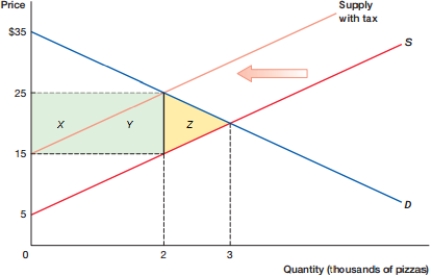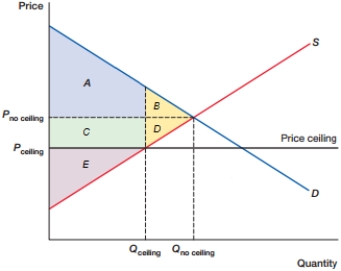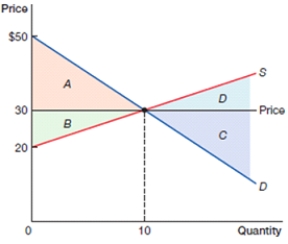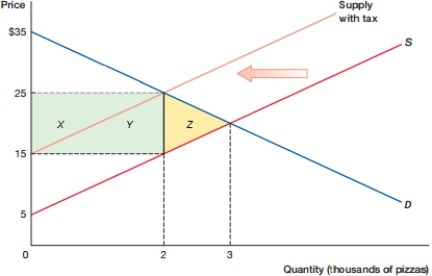A) a move toward equilibrium.
B) equilibrium.
C) greater competition.
D) deadweight loss.
Correct Answer

verified
Correct Answer
verified
Multiple Choice
(Figure: Price Ceiling 0) In the above figure, after the price ceiling is instituted, there is:

A) an equilibrium.
B) a shortage.
C) a surplus.
D) an efficient market.
Correct Answer

verified
Correct Answer
verified
Multiple Choice
Matt is selling a footstool in an online auction and is willing to accept $21 for the footstool. When the auction ends, the winning bid is $25. What is Matt's producer surplus?
A) $4
B) $21
C) $25
D) $46
Correct Answer

verified
Correct Answer
verified
Multiple Choice
Producer surplus increases when:
A) consumer surplus increases.
B) consumer surplus decreases.
C) prices fall.
D) prices rise.
Correct Answer

verified
Correct Answer
verified
Multiple Choice
(Figure: DWLA) In the figure, what is the new equilibrium price after the tax?

A) $2
B) $3
C) $15
D) $25
Correct Answer

verified
Correct Answer
verified
Multiple Choice
(Figure: DWL0) In the figure, what is the total consumer surplus at equilibrium?

A) A + B
B) A + C
C) B + D
D) C + E
Correct Answer

verified
Correct Answer
verified
Multiple Choice
(Figure: Producer Surplus 0) The price is $25. In the table, what is Mark's willingness to accept?
A) $5
B) $15
C) $20
D) $25
Correct Answer

verified
Correct Answer
verified
Multiple Choice
_____ is obtaining output for the lowest possible cost.
A) Productive efficiency
B) Allocative efficiency
C) Market failure
D) Deadweight loss
Correct Answer

verified
Correct Answer
verified
Multiple Choice
At _____, there is no other price or quantity that would result in a higher total surplus.
A) deadweight loss
B) consumer surplus
C) producer surplus
D) equilibrium
Correct Answer

verified
Correct Answer
verified
Multiple Choice
(Figure: Consumer, Producer, and Total Surplus) In the above figure, which area represents producer surplus?

A) A
B) B
C) C
D) D
Correct Answer

verified
Correct Answer
verified
Multiple Choice
According to most economists, the best way to eliminate shortages is to:
A) lower a price ceiling.
B) lower a price floor.
C) eliminate price controls.
D) raise a price ceiling.
Correct Answer

verified
Correct Answer
verified
Multiple Choice
The seller's gain from a sale-measured as the difference between the seller's willingness to accept and the actual price received-is called:
A) item scarcity.
B) consumer surplus.
C) item value.
D) producer surplus.
Correct Answer

verified
Correct Answer
verified
Essay
Who and why are the winners and losers when governments implement rent controls?
Correct Answer

verified
The winners under rent control are those...View Answer
Show Answer
Correct Answer
verified
View Answer
Multiple Choice
The equilibrium price for travel by taxi is $1 per mile. The local government sets a price ceiling of $3 per mile. What is the effect on the market for travel by taxi?
A) Market price rises to $4 per mile.
B) Market price rises to $3 per mile.
C) Market price rises to $2 per mile.
D) Market price remains at $1 per mile.
Correct Answer

verified
Correct Answer
verified
Multiple Choice
(Figure: DWLA) In the figure, what area represents tax revenue?

A) X
B) X + Y
C) Y
D) Z
Correct Answer

verified
Correct Answer
verified
Multiple Choice
Marta bids $15 for a shirt on an online auction site. She is the winning bid at $12. What is her consumer surplus?
A) $3
B) $12
C) $15
D) $27
Correct Answer

verified
Correct Answer
verified
Multiple Choice
Jerome bought a shirt for $15. He would have paid $20. Michael, the seller, would have sold it for $12. What is the total surplus resulting from the transaction?
A) $3
B) $8
C) $20
D) $27
Correct Answer

verified
Correct Answer
verified
Multiple Choice
Kerrie sold a footstool to Alan for $21. She would have taken $15. Alan was willing to pay $30. What is the total surplus resulting from the transaction?
A) $6
B) $9
C) $15
D) $21
Correct Answer

verified
Correct Answer
verified
Multiple Choice
When price increases, producer surplus could increase because:
A) price decreases.
B) new sellers enter the market.
C) consumer surplus increases.
D) consumer surplus decreases.
Correct Answer

verified
Correct Answer
verified
Multiple Choice
A price floor is intended to benefit:
A) consumers.
B) suppliers.
C) only the poor.
D) only the wealthy.
Correct Answer

verified
Correct Answer
verified
Showing 81 - 100 of 103
Related Exams